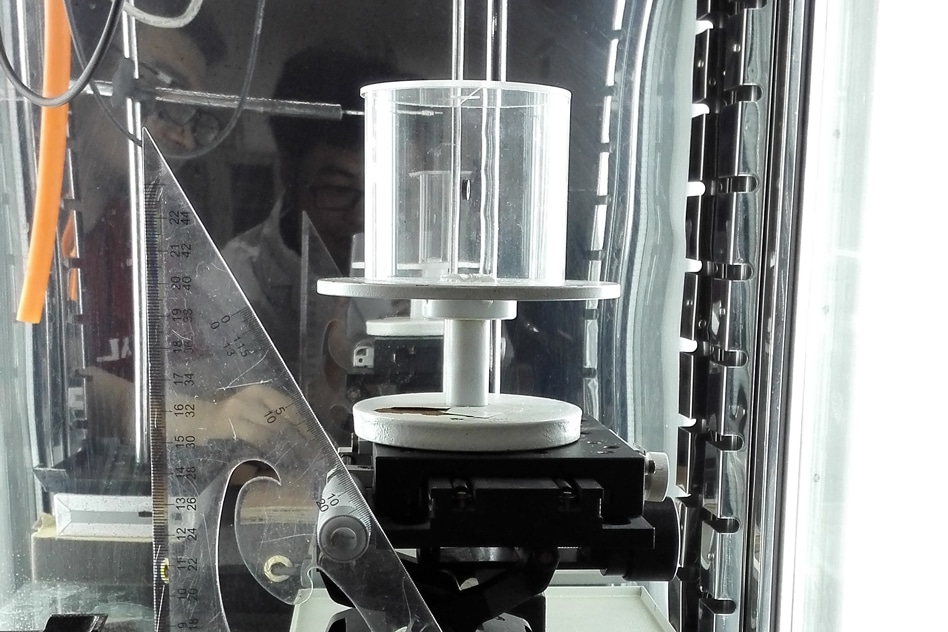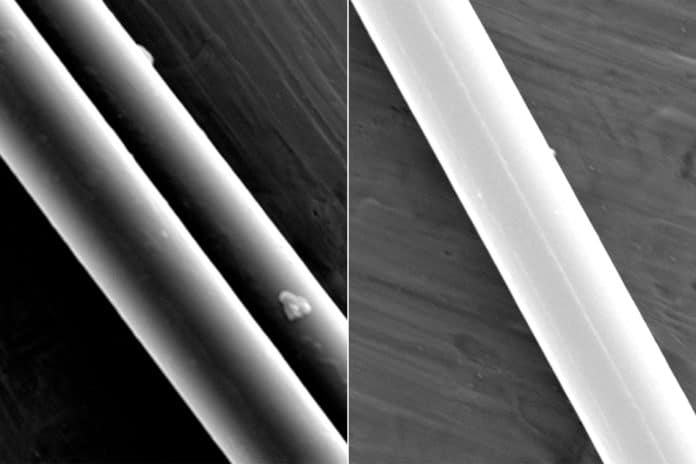The spider silk has some pretty impressive properties. It’s one of the sturdiest materials found in nature, stronger than steel and tougher than Kevlar. It can be stretched several times its length before it breaks. For these reasons, replicating spider silk in the lab has been a bit of an obsession among materials scientists for decades.
Now, MIT scientists have discovered one new unique property of spider silk called supercontraction. Scientists found that the silk fibers respond very strongly to humidity change and provide a strong torsional force.
Above a certain level of relative humidity in the air, they suddenly contract and twist, exerting enough force to be competitive with other materials being explored as actuators potentially.
Dabiao Liu, an associate professor at Huazhong University of Science and Technology in Wuhan, China, said, “We found this by accident initially. My colleagues and I wanted to study the influence of humidity on spider dragline silk. To do so, they suspended a weight from the silk to make a kind of pendulum and enclosed it in a chamber where they could control the relative humidity inside. When we increased the humidity, the pendulum started to rotate. It was out of our expectations. It really shocked me.”
Scientists tested a number of other materials, including human hair, but found no such twisting motions in the others they tried.
According to scientists, this unusual property could lead to new artificial muscles or robotic actuators.
MIT Professor Markus Buehler, head of the Department of Civil and Environmental Engineering, said, “This could be very interesting for the robotics community, as a novel way of controlling certain kinds of sensors or control devices. It’s very precise in how you can control these motions by controlling the humidity.”
Pupa Gilbert, a professor of physics, chemistry, and materials science at the University of Wisconsin at Madison, who was not involved in this work, said, “This is a fantastic discovery because the torsion measured in spider dragline silk is huge, a full circle every millimeter or so of length. This is like a rope that twists and untwists itself depending on air humidity. The molecular mechanism leading to this outstanding performance can be harnessed to build humidity-driven soft robots or smart fabrics.”

Photo courtesy of the researchers
Well, according to the spider’s point of view, the purpose of this twisting remained a mystery. But, scientists think that this super contraction in response to moisture may be a way to make sure a web is pulled tight in response to morning dew, perhaps protecting it from damage and maximizing its responsiveness to vibration for the spider to sense its prey.
Buehler reported, “We haven’t found any biological significance for the twisting motion. But through a combination of lab experiments and molecular modeling by the computer, they have been able to determine how the twisting mechanism works. It turns out to be based on the folding of a particular kind of protein building block, called proline.”
Former postdoc Anna Tarakanova and undergraduate student Claire Hsu at MIT said, “Investigating that underlying mechanism required detailed molecular modeling. We tried to find a molecular mechanism for what our collaborators were finding in the lab. And we actually found a potential mechanism based on the proline. They showed that with this particular proline structure in place, the twisting always occurred in the simulations, but without it there was no twisting.”
Liu explained, “Spider dragline silk is a protein fiber. It’s made of two main proteins, called MaSp1 and MaSp2. The proline, crucial to the twisting reaction, is found within MaSp2, and when water molecules interact with it they disrupt its hydrogen bonds in an asymmetrical way that causes the rotation. The rotation only goes in one direction, and it takes place at a threshold of about 70 percent relative humidity.”
Buehler said, “The protein has a rotational symmetry built in. And through its torsional force, it makes possible a whole new class of materials. Now that this property has been found, maybe it can be replicated in a synthetic material. Maybe we can make a new polymer material that would replicate this behavior.”
Taraknova said, “Silk’s unique propensity to undergo supercontraction and exhibit a torsional behavior in response to external triggers such as humidity can be exploited to design responsive silk-based materials that can be precisely tuned at the nanoscale. Potential applications are diverse: from humidity-driven soft robots and sensors, to smart textiles and green energy generators.”
Buehler said, “It may also turn out that other natural materials exhibit this property, but if so this hasn’t been noticed. This kind of twisting motion might be found in other materials that we haven’t looked at yet. In addition to possible artificial muscles, the finding could also lead to precise sensors for humidity.”
Yonggang Huang, a professor of civil and environmental engineering and mechanical engineering at Northwestern University, who was not involved in this work, said, “These researchers have used silk’s known high sensitivity to humidity and demonstrated that it can also be used in an interesting way to create very precise torsional actuators. Using silk as a torsional actuator is a novel concept that could find applications in a variety of fields from electronics to biomedicine, for example, hygroscopic artificial muscles and humidity sensors.”
“What is particularly noteworthy about this work is that it combines molecular modeling, experimental validation, and a deep understanding by which elementary changes in chemical bonding scale up into the macroscopic phenomena. This is very significant from a fundamental science point of view, and also exciting for applications.”
The work included collaborators at Huazhong University of Science and Technology and Hubei University, both in Wuhan, China, and the Queen Mary University of London. It was supported by the National Natural Science Foundation of China, the National Science Foundation of Hubei Province, the Young Elite Scientist Sponsorship Program by CAST, the National Institutes of Health, the MIT Undergraduate Research Opportunities Program, and the Office of Naval Research.
Journal Reference
- Dabiao Liu et al., Spider dragline silk as torsional actuator driven by humidity. Science Advances. 5, eaau9183 (2019). DOI: 10.1126/sciadv.aau9183
